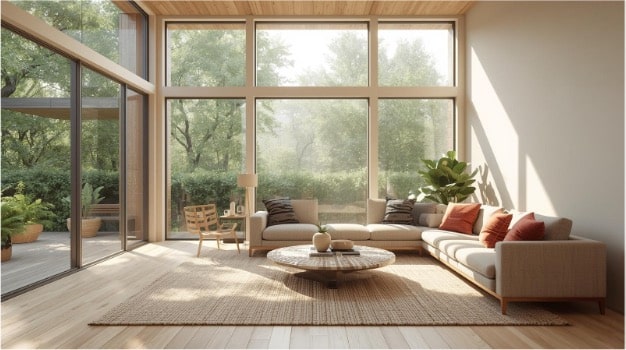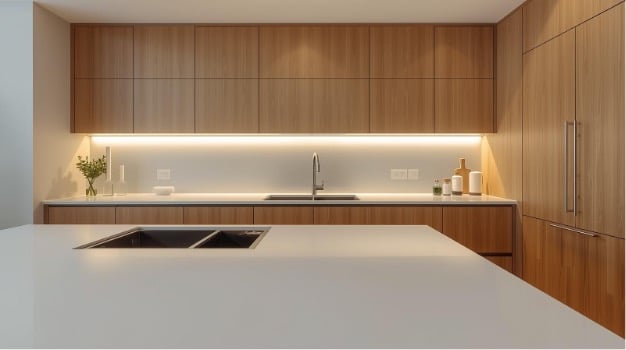In today’s construction world, homeowners are demanding more than beauty and function. They want spaces that are affordable to operate, environmentally responsible, and designed for modern living. By blending eco-friendly practices with cutting-edge design, builders can deliver remodels and new builds that bring long-term value across communities.
Below, we share insights on how sustainability and innovative design can shape the future of construction—while keeping affordability at the forefront.
What Sustainability Really Means in Construction
Sustainability in construction isn’t just about using “green” products. It’s a mindset that considers the entire lifecycle of a home:
- Embodied energy – How much energy went into producing, transporting, and installing
- Operational efficiency – How much energy and water a home consumes once
- Durability & adaptability – How long materials last and how easily a home can be updated without waste.
- Health & well-being – Indoor air quality, natural light, and ventilation that support healthier living.
The most effective projects evaluate each of these factors to ensure the finished structure looks beautiful, performs efficiently, and stands strong for decades.
Innovations in Building Design That Save Money & the Planet
Smarter Materials for Lasting Value
Material choice is a cornerstone of sustainability. FSC-certified wood, recycled content, and low-VOC paints reduce environmental impact and improve indoor health. Many of these are cost-competitive, and their longevity means fewer replacements down the line.
Energy Efficiency as a Standard, Not an Upgrade
In warm climates, energy use is dominated by cooling. High-R insulation, reflective roofing, and low-e windows cut heat gain dramatically. Treating these as baseline standards—not optional extras—directly reduces utility bills and long-term energy demand.
Smarter Layouts & Orientations
Good design makes a home naturally efficient. By orienting rooms for maximum daylight, designing roof overhangs for shade, and allowing cross-ventilation, reliance on artificial lighting and HVAC systems can be significantly reduced. Many remodels transform dark, closed layouts into open, airy spaces that require less energy to stay comfortable.
A Proven Process for Sustainable Remodeling
Sustainable and innovative design only works if supported by the right process. The most effective approach typically includes:
- Collaborative Planning: Begin by listening to goals: lower bills, modern layouts, eco-materials, or long-term durability.
- Transparent Budgeting: Present material and system choices not just by price, but by performance and lifecycle cost.
- Design Iteration: Use models to simulate natural light, airflow, and energy
- Precise Execution: Proper insulation, sealing, and installation ensure systems perform as designed.
- Post-Build Care: Educate clients on maintenance and provide upgrade recommendations for future efficiency improvements.
For homeowners ready to take the next step, our Remodeling Services detail how expert planning, eco-friendly materials, and precise execution can transform any space into a sustainable, modern home.
Busting Myths About Green Construction
Too many homeowners hesitate to “go green” because of misconceptions. Let’s clear up three big ones:
Myth 1: Green buildings are too expensive.
Reality: While some materials carry higher upfront costs, many upgrades, like insulation, low-flow fixtures, and efficient windows,quickly pay for themselves in reduced bills.
Myth 2: Eco-friendly means sacrificing style.
Reality: Modern design and sustainability enhance each other. Natural materials, open layouts, and abundant light deliver both beauty and performance.
Myth 3: Green homes are harder to maintain.
Reality: Durable, high-quality materials last longer and resist issues like rot or mold. With proper construction, eco-friendly homes are often easier to maintain.
Practical Tips for Homeowners Considering Green Remodeling
If you’re thinking about a remodel or new build, here are actionable ways to make it eco-friendly without breaking the bank:
- Ask about insulation values (R-value) and window
- Choose certified or locally sourced wood for cabinetry and
- Install low-flow faucets, dual-flush toilets, and drought-tolerant
- Position new rooms to maximize daylight and cross-
- Compare lifecycle costs not just upfront prices when choosing
These small steps create long-term savings and a more comfortable home. Looking for inspiration? Explore our Portfolio of Projects to see real examples of kitchens, bathrooms, and living spaces designed with energy efficiency and sustainability in mind.

Why It Matters For Your Wallet & The Planet
Building sustainably isn’t just good for the planet, it’s smart economics. Homeowners benefit from:
- Lower energy and water
- Increased resale value and
- Healthier indoor
- Long-term durability with fewer costly
Sustainable construction and innovative design create homes that look beautiful, function efficiently, and provide peace of mind for years to come. They’re not just trends, they’re the future of building.





